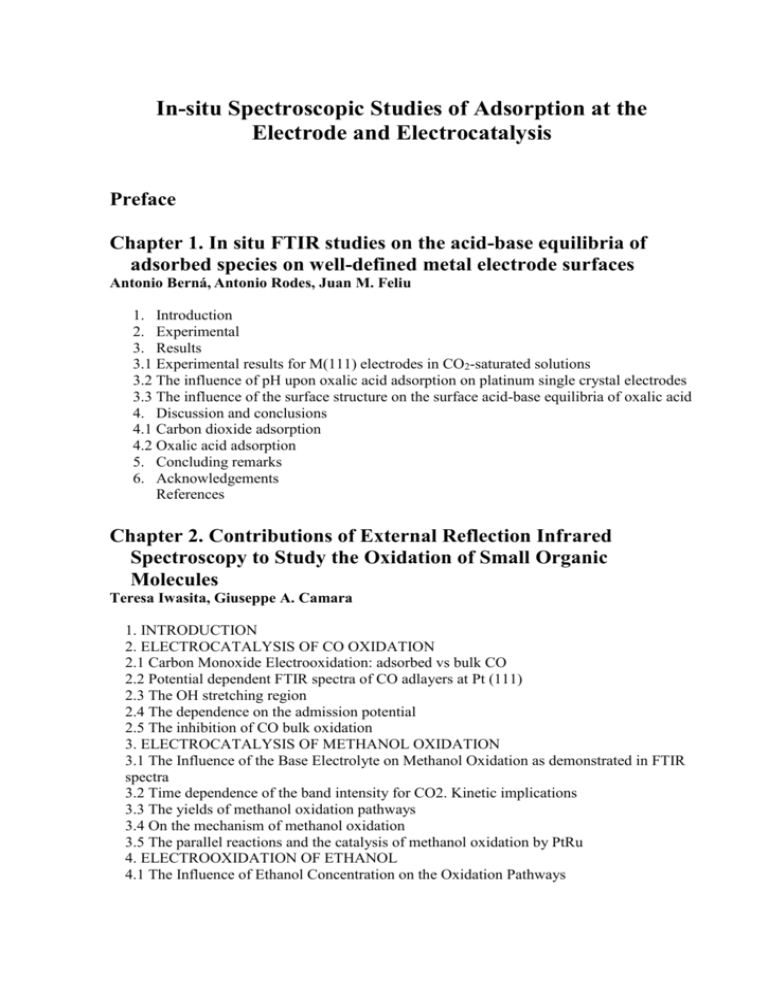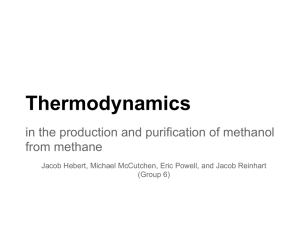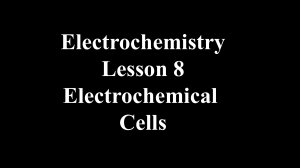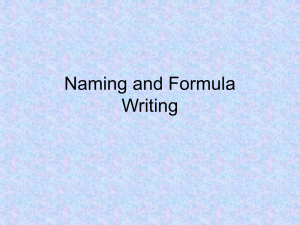Chapter 8 - Elsevier
advertisement

In-situ Spectroscopic Studies of Adsorption at the Electrode and Electrocatalysis Preface Chapter 1. In situ FTIR studies on the acid-base equilibria of adsorbed species on well-defined metal electrode surfaces Antonio Berná, Antonio Rodes, Juan M. Feliu 1. Introduction 2. Experimental 3. Results 3.1 Experimental results for M(111) electrodes in CO2-saturated solutions 3.2 The influence of pH upon oxalic acid adsorption on platinum single crystal electrodes 3.3 The influence of the surface structure on the surface acid-base equilibria of oxalic acid 4. Discussion and conclusions 4.1 Carbon dioxide adsorption 4.2 Oxalic acid adsorption 5. Concluding remarks 6. Acknowledgements References Chapter 2. Contributions of External Reflection Infrared Spectroscopy to Study the Oxidation of Small Organic Molecules Teresa Iwasita, Giuseppe A. Camara 1. INTRODUCTION 2. ELECTROCATALYSIS OF CO OXIDATION 2.1 Carbon Monoxide Electrooxidation: adsorbed vs bulk CO 2.2 Potential dependent FTIR spectra of CO adlayers at Pt (111) 2.3 The OH stretching region 2.4 The dependence on the admission potential 2.5 The inhibition of CO bulk oxidation 3. ELECTROCATALYSIS OF METHANOL OXIDATION 3.1 The Influence of the Base Electrolyte on Methanol Oxidation as demonstrated in FTIR spectra 3.2 Time dependence of the band intensity for CO2. Kinetic implications 3.3 The yields of methanol oxidation pathways 3.4 On the mechanism of methanol oxidation 3.5 The parallel reactions and the catalysis of methanol oxidation by PtRu 4. ELECTROOXIDATION OF ETHANOL 4.1 The Influence of Ethanol Concentration on the Oxidation Pathways 4.2 The influence of the catalyst: Ethanol oxidation on PtRu electrodeposits 5. Concluding remarks References Chapter 3. Contribution of in situ Infrared Reflectance Spectroscopy in the study of nanostructured fuel cell electrodes Jean-Michel Léger and Françoise Hahn Introduction 1. Fuel cells and Electrocatalysis 2. In situ infrared reflectance spectroscopy Introduction Methods In situ reflectance spectra 3. In situ infrared reflectance spectroscopy studies of reactions involved in fuel cells Introduction Cases of CO and methanol oxidation at PtRu bulk alloy electrodes. Preparation of nanostructured electrocatalysts Influence of particle size Effect of the structure of nanoparticles: example of Pt-Ru/C. Adsorbed CO poison or reactive intermediate for methanol oxidation? Oxidation of ethanol at Pt-Sn/C. Mobility of CO at the electrode surface. Behavior of trimetallic platinum-based nanostructured electrocatalyst. Electroreduction of oxygen 4. Conclusion 5. Acknowledgments References Chapter 4. In-situ FTIR spectroscopic studies of the adsorption and oxidation of small organic molecules at the Ru(0001) electrode under various conditions Wen-Feng Lin, Paul A Christensen and Jia-Mei Jin 1. Introduction 2. Experimental 3. Results and discussion 1. Surface structure and electrochemical characterization of the Ru(0001) electrode in perchloric acid solution 3.2. Reactivity of the Ru(0001) electrode towards the adsorption and electrooxidation of CO in perchloric acid solution as a function of temperature 3.2.1. The FTIR data at 25 C 3.2.2. The FTIR data at 10 and 50 C 3.2.3. Comparison of rate of oxidation of the CO adlayer at constant potential at 10, 25 and 50 C 3.2.4. Surface relaxation and compression of the sub-monolayer CO adlayer 3.3. Reactivity of the Ru(0001) electrode towards the adsorption and electrooxidation of formaldehyde, formic acid and methanol as a function of temperature 3.3.1. Formaldehyde electrooxidation 3.3.2. Formic acid electrooxidation 3.3.3 Methanol electrooxidation 3.4. Reactivity of the Ru(0001) towards the oxidation of CO adsorbates under open circuit conditions 3.4.1 The open circuit oxidation of CO adsorbates on the Ru(0001) in perchloric acid solution 3.4.2 The open circuit oxidation of CO adsorbates on the Ru(0001) electrode in sulfuric acid solution 3.5. The possible mechanisms of CO oxidation under open circuit conditions — a comparison of the data obtained at gas/solid and electrolyte/solid interfaces 4. Concluding remarks References Chapter 5. In situ microscope FTIR reflection spectroscopy and its applications in electrochemical adsorption and electrocatalysis on nanostructured surfaces Shi-Gang Sun and Zhi-You Zhou 1.Introduction 2. Instrumentation and principle of in situ microscope FTIR reflection spectroscopy (MFTIRS) 2.1 The setup of MFTIRS 2.2 The principle of MFTIRS 2.3 The technology of in situ time-resolved MFTIRS 3. Surface combinatorial studies of anomalous IR properties of nanostructured surfaces of Pt and Ru using in situ MFTIRS 3.1 The individua1 addressable array of microelectrode (IAM) 3.2 The combination of in situ MFTIRS with the IAM 3.3 Nanostructured Pt thin films constructed through the induction of fast potential cycling (FPC) 3.4 Nanostructured Pt thin films formed through square wave potential cycling 3.5 Nanostructured Ru thin films prepared through electrodeposition 4. Studies of electrochemical kinetics using SSTR-MFTIRS 4.1 Characterization of the SSTR-MFTIRS 4.1.1 The time constant of the in situ IR cell 4.1.2 Design of microelectrode for SSTR-MFTIRS 4.1.3 Dynamics of CO adsorbed on nanostructured surfaces 4.2 Dynamics of irreversible reaction on nanostructured surfaces 4.2.1 The design of flow thin layer IR cell and microelectrode 4.2.2 The kinetics of CO oxidation 5. Studies of electrocatalytic oxidation of methanol on nanostructured Pt using rapid-scan time-resolved MFTIRS (RSTR-FTIRS) 5.1 RSTR-MFTIR spectra of methanol oxidation 5.2 Dynamic processes of methanol oxidation5.3 Mechanism of methanol oxidation on nanostructured Pt microelectrode in alkaline solutions 6. Summary Acknowledgements References Chapter 6. IR spectroelectrochemistry: instrumentation and applications of external reflection, ATR and transmission sampling C. Korzeniewski 1. INTRODUCTION 2. INSTRUMENTATION AND SPECTRAL ACQUISITION METHODS 2.1. In situ sampling methods 2.2. Spectrometer systems 2.3. Sensitivity considerations 3. APPLICATIONS 3.1. Recent applications of external reflection sampling for studies in electrocatalysis 3.1.1. Single crystal electrodes 3.1.2. Bimetallic Electrodes 3.1.3. Nanoparticle catalysts 3.2. External reflection sampling for quantitative studies of molecular orientation on electrodes 3.3 Applications of SEIRA spectroscopy in electrochemistry 3.4 Applications of transmission infrared sampling in electrochemistry 3.4.1. Spectroelectrochemistry of redox proteins 3.4.2. Quantitative CO2 determinations 3.4.3. Studies of polymer electrolyte membrane 4. Summary References Chapter 7 Electrocatalytic Reactions on Platinum Electrodes Studied by Dynamic Surface-Enhanced Infrared Absorption Spectroscopy (SEIRAS) M. Osawa 1. Introduction 2. Mechanism of SEIRA 3. Experimental aspects 3.1. Electrochemical cell and optics 3.2. Preparation of thin film electrodes 4. Selected examples 4.1. Adsorption and oxidation of CO on Pt 4.2. Formic acid oxidation 4.2.1. Combined CV and SEIRAS measurements 4.2.2. Reaction intermediate 4.2.3. Kinetics of formic acid oxidation 4.2.4. Electrochemical oscillations in formic acid oxidation 4.3. Methanol Oxidation 4.3.1. Reaction intermediate in the direct path 4.3.2. Oxygen source for CO oxidation 4.4.Hydrogen evolution and oxidation on Pt 4.5. Other electrocatalytic reaction systems 5. Summary and future prospects Aknowledgements References Chapter 8 In-situ spectroscopy of operating fuel cells Eugene S. Smotkin 1. Introduction 2. Infrared reflectance spectroscopy of CO adsorbed on arc-melted Pt alloy surfaces 3. Infrared spectroscopy of CO adsorbed on MEA surfaces in operating fuel cells 4. X-ray absorption spectroscopy of operating fuel cells 5. Summary References Chapter 9 Vibrational and electronic spectroscopic investigation of the electrochemical interface using IR-Visible Sum Frequency Generation and related nonlinear optical techniques Abderrahmane Tadjeddine, Franck Vidal 1. Introduction 2. Basic concepts of second order nonlinear optical processes at interfaces 3. Experimental part 3.1. SFG experiments 3.2. Electrochemical cells 4. Spectroscopic investigations of the electrochemical interface 4.1. IR-visible sfg vibrational spectroscopy 4.2. Time-resolved studies of vibrational dynamics 4.3. Studies of the surface electronic properties 5. Conclusion References Chapter 10 In situ Raman Spectroscopic Studies of Pyridine Adsorption on Different Transition-Metal Surfaces Bin Ren, De-Yin Wu, Zhong-Qun Tian 1. Background 2. Experimental 2.1. Preparation of SERS-active electrode surface 2.1.1. Electrochemical oxidation-reduction cycles (ORC) for preparing Fe, Co and Ni electrodes 2.1.2.Electrochemical ORC for preparing Pt and Pd electrodes 2.2 Raman Instrumentation 2.2.1. Strategies to Increase the Detection Sensitivity 2.2.2. Confocal Raman Microscope 2.2.3. Optimization of the Experimental Setup 3. Vibrational Properties of Pyridine 3.1. Molecular structure and basic vibrational properties of free pyridine 3.2. Vibrational properties of surface species 3.3. Surface Selection Rules 4. Experimental results 4.1 Pyridine adsorption on Fe 4.2 Pyridine adsorption on Co 4.3 Pyridine adsorption on Ni 4.4 Pyridine adsorption on Pd 4.5 Pyridine adsorption on Pt 5. Comparison of the experimental results of pyridine adsorption on different metal surfaces 5.1. The frequencies of the ν1 and ν6a modes for pyridine on different metal surfaces 5.2. The relative intensity of the ν6a, ν9a and ν8a modes to the ν1 mode 5.3. The relative intensity change of the ν12 (1037 cm-1) and ν18a (1067 cm-1) bands 5.4. The intensity and frequency of the M-N band 6. Theoretical calculation 6.1. Vibrational frequency shift and binding interaction 6.2. Interpretation of the relative intensity changes based on the surface enhanced non-resonance Raman effect 6.3. Charge-transfer enhancement 7. Summary 8. Acknowledgement 9. References Chapter 11 In-situ Surface X-ray Scattering and Infra-red Reflection Adsorption Spectroscopy of CO Chemisorption at the Electrochemical Interface Christopher A. Lucasa and Nenad M. Markovicb 1. Introduction 2. Instrumentation and methods of characterization 2.1. Electrochemical measurements 2.2. Surface x-ray scattering 2.3. IRAS measurements 3. CO adsorption onto Pt and Au 3.1. High pressure UHV studies 3.2. Structural studies in electrochemistry 3.2.1. CO ordering on the Pt(111) surface 3.2.2. Au(hkl) Surfaces 3.3. Au versus Pt 3.4. Structure sensitivity and reaction mechanism 3.5. New challenges 4. Summary Acknowledgements References Chapter 12 Resonance elastic and inelastic X-ray Scattering Processes for in-situ Investigation of Electrochemical Interfaces K.-C. Chang, A. Menzel, V. Komanicky, H. You J. Inukai, A. Wieckowski E. V. Timofeeva, Y. V. Tolmachev 1. Introduction 2. X-ray interactions with atoms 3. Experimental 4. X-ray Fluorescence Studies 4.1. Glancing-incidence x-ray fluorescence spectroscopy 4.2. High-resolution fluorescence spectroscopy 4.3. Fluorescence spectra from surfaces of nanoparticles 5. Surface Anomalous Resonance X-ray Scattering and Polarization Dependence 5.1. Platinum surface anodic oxidation 5.2. Sulfate adsorbed on Pt(111) surface 5.3. Carbon monoxide adsorbed on Pt(111) 6. Conclusion Acknowledgement References Chapter 13 In-situ ESR for studies of paramagnetic species on electrode surfaces and electron spins inside electrode materials Lin Zhuang, Juntao Lu* 1. Introduction 2. ESR principles 2.1. Electron spin resonance 2.2. Hyperfine splitting 2.3. Line width 2.4. Anisotropies of g-factor and hfs-constant 2.5. Curie spins and Pauli spins 2.6. Microwave penetration depth in conducting samples and Dyson line shape 3. Cell design for in-situ esr measurements 4. Simultaneous electrochemical and esr measurements 5. Paramagnetic species on electrode surfaces 5.1. Adsorbed radicals 5.2. FeFc modified electrodes 6. Conducting polymers 6.1. Simultaneous electrochemical-resistance-ESR measurements 6.2. Variable temperature in-situ ESR measurements 7. Lithium intercalation into carbons 7.1. The band model for lithium intercalation into carbons 7.2. ESR determination of density of electronic states at Fermi level for lithiated carbons 7.3. Separating the band model from other intercalation mechanisms 8. Summary remarks Acknowledgement References Chapter 14 Coupling Interfacial Electrochemistry with Nuclear Magnetic Resonance Spectroscopy: An Electronic Perspective YuYe Tong 1. Introduction 2. Fundamentals 2.1 NMR Basics 2.2 d–Band Structure, d–Band Center, and the Ef–LDOS 2.3 CO–Metal Bonding: Electronic Band Perspectives of the 5 Forward and 2* Back Donation 3. Electronic Nature of Stark tuning effect 3.1 CN– on Polycrystalline Pt Surfaces 3.2 CO on Pt Surfaces: A Correlation between 13C EC-NMR and IR 3.3 CO on Polycrystalline Pd Surfaces 4. Electronic Effect of Alloying Pt surfaces: Ru vs. Pd 5. Summary and Outlook Acknowledgments References Chapter 15 From stepped single crystal surfaces to ordered bimetallic electrodes: Impact on electro catalysis and adsorption Helmut Baltruschat, Rainer Bußar, Siegfried Ernst and Fernando Hernandez Institute of Physical and Theoretical Chemistry, University of Bonn, Roemerstr. 164, D-53117 Bonn, Germany Introduction 1. Fundamentals 1.1. Definition of a Monolayer and the Surface Unit Cell for Stepped Surfaces 1.2 . Preparation of Stepped Surfaces of Gold and Platinum Single Crystals 1.3.Characterization by cyclic voltammetry 1.4. Anion adsorption and the point of zero charge 2. METAL DEPOSITION AT STEPPED SURFACES 2.1. Upd at stepped surfaces and step decoration 2.1.1. Step decoration 2.1.2. Influence of steps on the rate of upd 2.2. Bulk metal deposition at stepped surfaces 3. Differential Electrochemical Mass Spectrometry 3.1. Calibration of the mass spectrometer 3.2. Cell designs for DEMS 3.2.1. The one compartment thin layer cell 3.2.2. Dual thin layer cell for continuous flow through of electrolyte 3.3. Mass spectrometric cyclic voltammetry 4. ROLE OF STEPS IN ELECTROCATALYSIS 4.1. Rate of hydrogen evolution and oxygen reduction 4.2. Influence of steps on coverage 4.3. Hydrogenation of adsorbed small organic molecules 4.3.1. Hydrogenation of adsorbed benzene and cyclohexene 4.3.2. Hydrogenation of adsorbed ethene 4.4. Oxidation of CO and small organic molecules 4.4.1. Oxidation of carbon monoxide 4.4.2. Adsorption and oxidation of methanol 5. step decorated surfaces as model bimetallic surfaces (influence of step decoration on adsorption): 5.1. The action of cocatalysts 5.2. Step decoration for studying cocatalytic effects in CO and methanol oxidation 5.2.1. Pt/Ru 5.2.2. Methanol oxidation at Ru modified Pt single crystal electrodes 5.2.3. The influence of Sn and Mo on CO oxidation 5.3.Pd on regularly stepped Au surfaces 5.3.1. Pd dissolution on Au(332)/Pd 5.3.2. CO and benzene on Au(332)/Pd 5.3.3. H2 evolution on Au(332)/Pd 6. Concluding remarks Reference 10









